Last updated on December 30th, 2023 at 02:48 pm
So, you decided to start building your first home studio and you read all these great things about some awesome mics out there only to find that you now have even less of a clue of what to buy because there are way too many options.
In this post I’ll compare two of the best-known microphones out there in order to help you decide; the Audio-Technica AT2020 and the Rode NT1-A.
I’ll do a quick overview of both, list their features, specifications, how they both perform, what you get in the box and at the end I’ll give you my opinion on which one you should get.
If you want to only find out about the basic differences then scroll down all the way to the end where I list them.
Let’s get started…
Audio-Technica AT2020
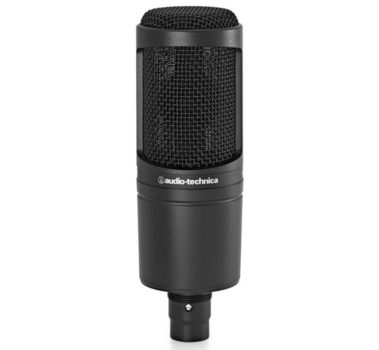
There are probably few better-known brands in the music industry than Audio-Technica.
They make some of the best microphones on the market and the AT2020 is the go-to mic for almost every beginner home recording enthusiast.
Plus, you won’t see a studio that doesn’t at least have a couple of them…
The AT2020 is a cardioid condenser microphone, which means that it is going to need phantom power in order to work properly… Like all condenser microphones.
More on this in a bit…
Just like all the Audio-Technica microphones, the AT2020 is extremely well built.
When holding it in my hand it doesn’t feel like a cheap product at all, quite the opposite in fact.
However, since it’s a condenser microphone, I wouldn’t recommend dropping it or not worrying too much about it taking a beating…
Condenser microphones are a bit more sensitive in this sense than dynamic mics, so keep this in mind.
The AT2020 can be used for a lot of different applications, such as;
Recording music, doing voice-over work, streaming, creating YouTube videos, and more.
Since the Audio-Technica AT2020 has a Cardioid pickup pattern, it will mostly be picking up sound from the front while rejecting sound from the back and the sides.
This is essential because you want to avoid picking up unwanted noises and any of the room’s natural sound, and a cardioid pattern will help with this quite a lot!
It has a frequency response of 20Hz-20kHz which is standard for almost every large diaphragm condenser microphone out there.
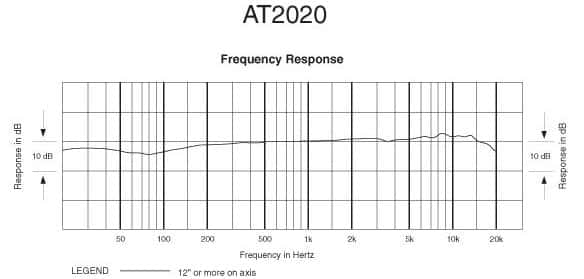
Important note: In the beginning I mentioned that in order to record properly, the AT2020 will need a phantom power supply.
The good news is that almost every modern Audio Interface, even the cheapest ones, will be able to supply it.
However, some microphones can work within a range of voltages, like 11-52v, but the AT2020 needs exactly 48v of phantom power.
So, if you don’t already own an Audio Interface and are looking to purchase one, here are a couple articles I wrote which should be very helpful.
- Best Audio Interfaces under $300
- UMC22 Vs UM2 (Cheapest ones)
- Scarlett 2i2 vs UMC204HD (Higher quality and affordable)
- Scarlett 6i6 vs UMC 404HD (A bit more expensive but very cost-efficient)
How does it perform?
The recording quality is great, especially since this microphone costs only about $100.
It has a slightly reduced low-end which I personally don’t like for the simple fact that ends up lacking a bit of “body”, plus I prefer to control this in post later on.
The slight boost in the mid-high frequencies can actually help your vocals to better cut through the mix, which is always nice!
All in all, it’s a terrific mic to get if you’re on a budget!
What comes in the box?
- The Audio-Technica AT2020 Mic
- A storage Pouch
- Microphone Clip
Features
- Great Build quality
- High SPL handling and wide dynamic range provide maximum versatility
- Cardioid polar patter which reduces the overall noise picked up
- 144 dB SPL Handling
Specifications
| Polar Pattern | Cardioid |
| Microphone type | Condenser |
| Frequency Response | 20 to 20,000 Hz |
| Output Impedance | Rated impedance is 100 Ohms |
| Connector | Three-pin (XLR), male |
| Max SPL | 144dB SPL |
| Sensitivity | -37dB |
| Self-Noise | 20dB |
Find out more about the AT2020 USB here.
- Audio-Technica AT2020 USB: Amazon, Sweetwater.
Rode NT1-A
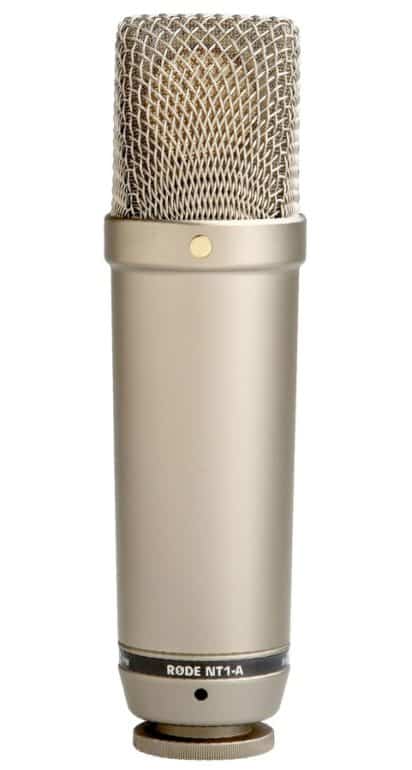
The Rode NT1-A is one of the most famous and used microphones in the recording industry.
Some people praise it as if it were the best microphone to be ever created and they even compare it to other ones that are in a much higher price range.
The reason why the Rode NT1-A is so good is because it will give you a very accurate representation of what is being recorded, meaning that it should easily fit within any mix.
It has a very natural sound, even though after reading some reviews online I found that people complained about it having a bit of a harshness, or high frequency/presence boost, which is actually quite common on microphones at this price range.
However, this all depends on your specific taste, since every microphone will have its own character.
Some people might find that it enhances their voice, while others may find that it makes their voice sound absolutely horrible and shrill.
In my particular case, I prefer the Rode NT1 which doesn’t sound as bright.
Now, as far as the build quality goes; I honestly can’t complain at all!
It’s absolutely fantastic and it’s built to last.
Sadly, the Rode NT1-A doesn’t come with a PAD or High–Pass filter, it’s just the bare microphone, but it is a great performer and it does what it’s supposed to do.
It has a slight boost at around 150Hz and at the 6k to 12kHz range, with a deep cut at the high-end;
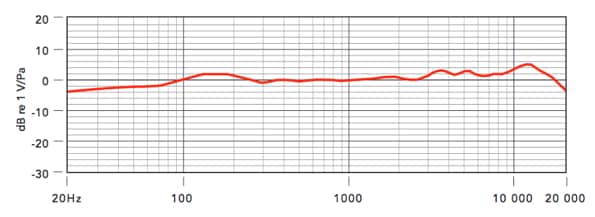
All this means that it will be actually quite bright sounding, which is what I referred to earlier by saying that people found it to be a bit harsh at times.
How does it Perform?
I found it great for recording vocals, acoustic guitar and electric guitar, but to be honest… once you get to this level of microphones it gets hard to really find one that doesn’t do what it’s supposed to.
It all comes down to your own preferences, what kind of tone you’re going for, etc.
I actually do like the high-end boost a bit since it gives it a more “airy” sound, although maybe not so much on MY vocals, but like I mentioned earlier, it all comes down to the source you are recording.
This is also something that works well with acoustic guitars, since that high-end boost really opens up the higher frequencies, making the guitar sound better.
What comes in the Box?
- The Rode NT1-A microphone.
- A Storage Pouch.
- You also get the shock mount which comes with a pop filter already attached.
- And lastly you get an XLR cable.
Features
- The build quality is fantastic.
- The shock mount is metal, when most included ones are made of plastic.
- It’s insanely quiet (Low self-noise).
- Open and Airy high-end.
- Can Handle high SPL.
Specifications
| Polar Pattern | Cardioid |
| Microphone type | Condenser |
| Frequency Response | 20 to 20,000 Hz |
| Output Impedance | Rated impedance is 100 Ohms |
| Connector | Three-pin (XLR), male |
| Max SPL | 137dB SPL |
| Sensitivity | -32dB |
| Self-Noise | 5dB |
Find out more about the Rode NT1a here:
- Rode NT1a: Amazon, Sweetwater.
Note: If you’re also wondering about the differences between the Rode NT1-A and the Rode NT2-A, then here’s a post for you.
Basic Differences
Both the Audio-Technica AT2020 and the Rode NT1-A feature a slight boost to their presence frequencies, but the boost is much more apparent on the NT1-A making it sound “airier” and even “Shrill” at times.
Additionally, the AT2020 has a cut on the lower frequencies while the NT1-A features a boost around the 150Hz mark, making the low end more apparent on the NT1-A.
Which one should You Choose?
Both microphones are great; However, the Rode NT1-A is a much better and clearer sounding microphone overall.
Of course, this comes at a higher price, but if you can afford it, then the Rode NT1-A should be your definite choice.
But please don’t think that I’m saying that the AT2020 is a bad mic, quite the contrary; It’s probably the most cost-efficient condenser microphone available.
So, if you’re a complete newbie and don’t want to spend too much, the AT2020 is a fantastic investment.
Conclusion
No matter which microphone you choose, you should be able to create high quality recordings from home, no questions asked.
Sure, the Rode might be better and you also won’t have any need to upgrade from it down the lane, which might happen with the AT2020…
But both of them are completely fine!
I hope this information was useful.
Have a wonderful day!
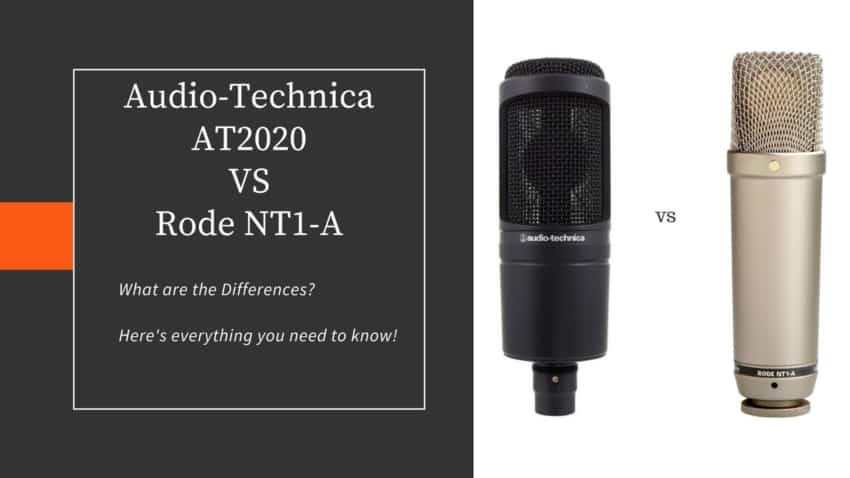
Thank you so much …im trying to get more VO work and I have the AT 2020, I am unsure if I need an upgrade of mic or need to get audio interface now?
great info …
Thank you, Facundo. Great information and well explained – extremely helpful. 🙂
Thanks, Facundo this comparison has really help me a lot as a beginner good work.